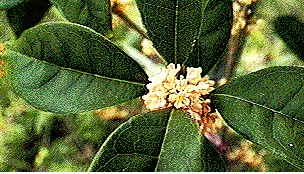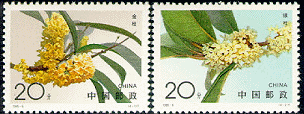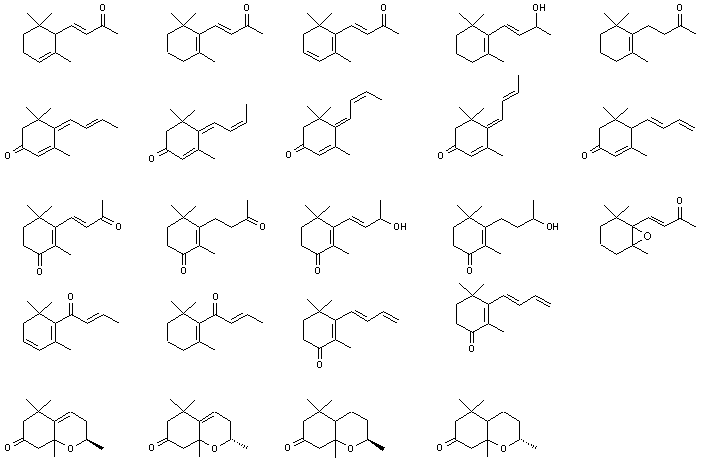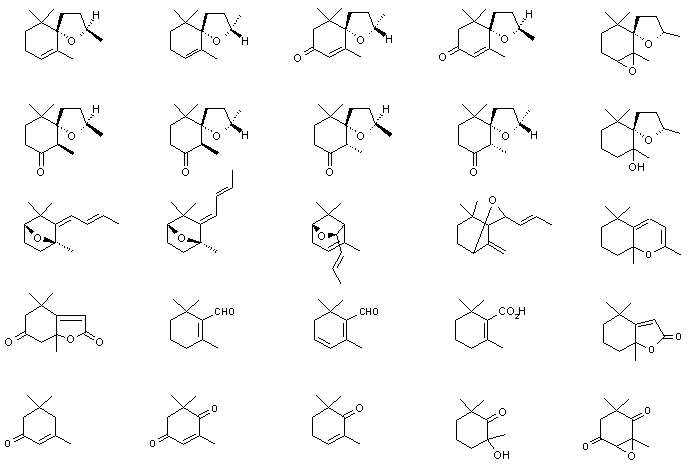|
Leffingwell &
Associates
|
|
A Review by John C. Leffingwell. Ph.D.
This a part of our series on aroma materials produced by carotenoid degradation.

 .....
.....
Osmanthus fragrans - Chinese Stamps (1995)
|
Leffingwell &
Associates
|
|
A Review by John C. Leffingwell. Ph.D.
This a part of our series on aroma materials produced by carotenoid degradation.

 .....
.....
Osmanthus fragrans - Chinese Stamps (1995)
Osmanthus fragrans is a flower native to China that is valued for its delicate fruity-floral apricot aroma. It is especially valued as an additive for tea and other beverages in the far east. While the flowers of osmanthus range from silver-white (Osmanthus fragrans Lour. var. latifolius Mak.) to gold-orange (Osmanthus fragrans Lour. var. thunbergii Mak.) to reddish (Osmanthus fragrans Lour. var. aurantiacus Mak.), the extract (alcohol absolute) is usually prepared from the gold-orange flowers. Osmanthus absolute is very expensive (~U.S. $4000.00 per kilogram) and accordingly is used in only the most expensive perfumes and flavors.
Various workers have examined the different colored varieties and find that the gold-orange variety (e.g., Osmanthus fragrans Lour. var thunbergii ) tends to have more of the desirous notes and tend to be higher in carotenoid derived materials. Among the carotenoids of Osmanthus are all trans-beta-Carotene, all trans-alpha-Carotene and Neo-beta-carotene B.
In addition to cis-jasmone, gamma-decalactone and various delta-lactones which contribute to the flavor of Osmanthus, an extensive number of ionone derivatives and Theaspirane derivatives derived from carotenoids are present. The stuctures of some of these are shown below:

.......
The following table shows the constituents reported by Kaiser and Lamparsky (1981) from an analysis of Osmanthus abosolute. In this work they specifically did not report on certain alcohols, esters and aldehydes (but do mention that these classes are present). Other workers note that cis-3-hexenol, cis-3-hexenyl butyrate, cis-3-hexenyl propionate, cis-3-hexenyl benzoate, cis-3-hexenyl 2-hexenoate, nonanal, octanal, decanal, benzaldehyde, ethyl hexanoate and other esters are present.
|
Constituent (as % of volatiles) |
% |
|
Linolenic acid |
17.4 |
|
Linoleic acid |
8.7 |
|
Palmitic acid |
8.6 |
|
beta-Ionone |
7.6 |
|
Oleic acid |
7.0 |
|
Dihydro-beta-ionone |
6.4 |
|
Ethyl linolenate |
6.3 |
|
(+)-Decan-4-olide |
4.0 |
|
Ethyl palmitate |
3.4 |
|
Ethyl linoleate |
3.1 |
|
Dihydro-beta-ionol |
3.0 |
|
Stearic acid |
1.7 |
|
trans-Geranic acid |
1.6 |
|
Eicosanol |
1.5 |
|
Ethyl oleate |
1.4 |
|
Geraniol |
1.2 |
|
p-Methoxyphenylethanol |
1.0 |
|
Tetradecanoic acid |
1.0 |
|
(-)-Linalool |
0.8 |
|
4-Oxo-dihydro-beta-ionol |
0.8 |
|
cis-Linalool oxide (furanoid) |
0.7 |
|
Retroionenes (4 isomers) |
0.7 |
|
trans-Linalool oxide (furanoid) |
0.6 |
|
alpha-Ionone |
0.6 |
|
cis-Linalool oxide (pyranoid) |
0.6 |
|
Ethyl stearate |
0.5 |
|
(+)-Theaspirane B (trans) |
0.4 |
|
p-Ethylphenol |
0.4 |
|
trans-Linalool oxide (pyranoid) |
0.4 |
|
(+)-Theaspirane A (cis) |
0.3 |
|
4-Hydroxy-beta-ionol |
0.3 |
|
4-Hydroxy-beta-ionone |
0.3 |
|
4-Oxo-beta-ionol |
0.3 |
|
4-Oxo-dihydro-beta-ionone |
0.3 |
|
6,10,14-Trimethyl-2-pentadecan-2-one |
0.2 |
|
6-Pentyl-alpha-pyrone |
0.2 |
|
Dihydro-alpha-ionone |
0.2 |
|
Ethyl tetradecanoate |
0.2 |
|
(-)-7-Oxodihydrotheaspirane B1 |
0.1 |
|
(+)-7-oxodihydrotheaspirane A1 |
0.1 |
|
(+)-Nerolidol |
0.1 |
|
2-Phenylethanol |
0.1 |
|
4-Oxo-beta-ionone |
0.1 |
|
1-Nonanol |
0.07 |
|
7(Z)-Decene-5-olide (Jasmin lactone) |
0.07 |
|
Citronellol |
0.07 |
|
Dodecan-4-olide |
0.07 |
|
Eugenol |
0.07 |
|
2(3)-Dehydrotheaspirane |
0.06 |
|
(-)-7-Oxodihydrotheaspirane A2 |
0.05 |
|
(+)-7-Oxodihydrotheaspirane B2 |
0.05 |
|
1-(2,6,6-Trimethyl-1,3-cyclohexadiene-1-yl)-3-butanone |
0.05 |
|
7(Z)-Decen-4-olide |
0.05 |
|
Benzyl alcohol |
0.05 |
|
Damascenone |
0.05 |
|
Dehydro-beta-ionone |
0.05 |
|
Dehydro-beta-ionone |
0.05 |
|
Ethyl nonanoate |
0.05 |
|
Ethyl octanoate |
0.05 |
|
p-Menth-l-en-9-al |
0.05 |
|
Photoisomer of beta-ionone |
0.04 |
|
1-(2,6,6-Trimethyl-1,3-cyclohexadiene-1-yl)-3-butanol |
0.03 |
|
beta-Ionone epoxide |
0.03 |
|
cis-jasmone |
0.03 |
|
Decan-5-olide |
0.03 |
|
Decan-5-olide (delta-Decalactone) |
0.03 |
|
Nerol |
0.03 |
|
Phenylacetonitrile |
0.03 |
|
(E)-Retroionol |
0.02 |
|
(E)-Retroionone |
0.02 |
|
1-(2,3,6-Trimethylphenyl)but-1-en-3-one |
0.02 |
|
2(Z),7(Z)-Decadien-5-olide |
0.02 |
|
2,5-Epoxy-megastigma-6(E),8(E)-diene |
0.02 |
|
5(Z),8(Z),11(Z)-tetradecatrien-4-olide |
0.02 |
|
alpha-Ionol |
0.02 |
|
alpha-Terpineol |
0.02 |
|
beta-Ionyl ethyl ether |
0.02 |
|
Coumarin |
0.02 |
|
Hexadecan-4-olide |
0.02 |
|
Hotrienol |
0.02 |
|
Megastigma-5,7(E),9-triene-4-one |
0.02 |
|
Nerol oxide |
0.02 |
|
Nonan-4-olide |
0.02 |
|
Octan-4-olide |
0.02 |
|
(Z)-Retroionol |
0.01 |
|
(Z)-Retroionone |
0.01 |
|
2-Decene-5-olide (Massiolactone) |
0.01 |
|
2-Methyl-2-vinyl-5-(2’-6methylhepta-2,6-dienyl)furan (2-isomers) |
0.01 |
|
3-Oxo-alpha-ionone |
0.01 |
|
4-Oxo-isophorone |
0.01 |
|
5(Z),8(Z)-tetradecadien-4-olide |
0.01 |
|
5(Z)-tetradecen-4-olide |
0.01 |
|
6,7-epoxy-theaspirane |
0.01 |
|
6-Heptyl-alpha-pyrone |
0.01 |
|
6-Hydroxy-dihydrotheaspirane |
0.01 |
|
6-Propyl-alpha-pyrone |
0.01 |
|
7(Z)-Decen-5-olide |
0.01 |
|
ar-Ionone |
0.01 |
|
cis-7,10-Epoxy-2,6,10-trimethyl-2,5(E),11-dodecatriene |
0.01 |
|
Geranyl acetate |
0.01 |
|
Megastigma-4,6,8-triene-3-ones (4-isomers) |
0.01 |
|
Megastigma-4,7(E),9-triene-3-one |
0.01 |
|
Megastigma-5,8(E),diene-4-one |
0.01 |
|
trans-7,10-Epoxy-2,6,10-trimethyl-2,5(E),11-dodecatriene |
0.01 |
|
2,5-Epoxy-megastigma-6(Z),8(E)-diene |
0.003 |
|
2,3-epoxy-4-oxo-isophorone |
<0.01 |
|
2,6,6-trimethylcyclohex-1-en-carboxylic acid |
<0.01 |
|
2,6,6-Trimethylcyclohex-2-en-1-one |
<0.01 |
|
2-Hydroxy-2,6,6-trimethylcyclohexanone |
<0.01 |
|
3-Oxo-retroionol |
<0.01 |
|
9-Oxo-dihydroeudalan (2-isomers?) |
<0.01 |
|
9-Oxo-eudalan (2-isomers?) |
<0.01 |
|
beta-Cyclocitral |
<0.01 |
|
beta-Damascone |
<0.01 |
|
Dihydroactinodiolide |
<0.01 |
|
Isophorone (3,5,5-trimethylcyclohex-2-en-1-one) |
<0.01 |
|
Safranal |
<0.01 |
|
Theaspirone |
<0.01 |
|
1-(2,3,6-Trimethylphenyl)but-1-en-3-ethoxy ether |
trace |
|
2,3,6-Trimethylphenylbutan-3-ol |
trace |
|
2,5-Epoxy-6-megastigmen-9-ol |
trace |
|
2,7-Epoxy-megastigma-4,8(E)-diene |
trace |
|
2-Methyl-2-vinyl-5-isopropenyfuran (2-isomers) |
trace |
|
4,7-Epoxy-megastigma-5(11),8(E)-diene |
trace |
|
9-Hydroxytheaspirane |
trace |
|
Dehydro-ar-ionone |
trace |
|
Hexan-4-olide |
trace |
References:
Ding, D.-S.; M.-L. Zhu, Z.-X. Huang, Z.-Y. Song and J.-P. Zhao, Aroma constituents of different varieties of 0smanthus fragrans flowers. Proceedings 11th International Congress of Essential Oils, Fragrances and Flavors, Editors., S. C. Bhattacharyya, N. Sen
Gogiya, V. T.; L. G. Kharebava, R. V. Gogiya and E. B. Gvatua, Composition of the volatile compounds in flowers of Osmanthus fragrans (Thunb.) Lour. Rastit. Resur., 22, 243-248 (1986).
Ishiguro, T.; N. Koga, and K. Nara, Components of the Flowers of Osmanthus fragrans II. Odorous Component Osmane and Acids. Yakugaku Zasshi, 77, 566-67 (1957).
Kaiser, R. and D. Lamparsky, 222. Inhaltsstoffe des Osmanthus Absolues. 4. Mitteilung: Mega-stigma-5,7(E),9-trien-4 -one und Megastigma-5,8(E)-dien4-one., Helv. Chim. Acta, 61, 2328--2335(1978).
Kaiser, R. and D. Lamparsky, 31. Inhaltsstoffe des Osmanthus Absolues. 1. Mitteilung: 2,5-epoxy-megastigma-6,8-dien., Helv. Chim. Acta, 61, 373-382 (1978).
Kaiser, R. and D. Lamparsky, 32. Inhaltsstoffe des Osmanthus Absolues. 2. Mitteilung: 2,7-epoxy-megastigma-4,8(E)-dien., Helv. Chim. Acta, 61, 383-386 (1978).
Kaiser, R. and D. Lamparsky, 33. Inhaltsstoffe des Osmanthus Absolues. 3. Mitteilung: Derivate der Theaspirane., Helv. Chim. Acta, 61, 387-400 (1978).
Kaiser, R. and D. Lamparsky, Natural Occurrence of New lonone Derivatives and their Structural Assignments by Synthetic Approaches, Paper No. 115, 7th International Essential Oil Congress, Kyoto, Japan (1977).
Kaiser, R. and D. Lamparsky, Volatile Con-stituents of Osmanthus Absolute. in Essential Oils. B. D. Mookheijee and C. J. Mussinan, eds., Allured Publishing, Wheaton, IL (1980), pp. 159-192
Komaki, R; The Constituents of the Essential Oil from Osmanthus Flower. Paper No. 117, 8th International Essential Oil Congress, Grasse (1980).
Lawrence, B.M., Progress in Essential Oils: Osmanthus, Perfumer & Flavorist, 17(3), 72-76 (1992).
Lawrence, B.M., Progress in Essential Oils: Osmanthus, Perfumer & Flavorist, 11(4), 76-79 (1986).
Mookherjee, B. D.; R. W. Trenkle and R. A. Wilson, Live vs. Dead, Part II. A comparative analysis of the headspace volatiles of some important fragrance and flavor raw materials. J, Essent. Oil Res., 2, 85-90 (1989).
Mookherjee, B. D.; R. W. Trenkle and R. A. Wilson, The chemistry of flowers, fruits and, spices: Live vs. Dead -- a new dimension in fragrance research. Pure Appl . Chem., 62, 1357-1364 (1990).
Ohloff, G.; Scent and Fragrances, The fascination of odors and their chemical perspectives; translated by W. Pickenhagen and B. Lawrence, Springer-Verlag, Pub., Berlin - Heidelberg;, 1994, pp. 166-172.
Sisido, K.; S. Ktirozumi, K. Utimoto and T. Isida, Fragrant Flower Constituents of Osmanthus fragrans II., Perf. Essent. Oil Rec., 58, 212-215 (1967).
Sisido, K.; S. Kurozumi, K. Utirnoto and T. Isida, Fragrant Flower Constituents of Osmanthus fragrans, Perf. Essent. Oil Rec., 57, 557-560 (1966).
Wen. G.-Y.; F.-I. Yu, H.-T. Wang. Z.-Q. Kang, K. Jiang and Y. M. Bian. Studies on Chemical Constituents of the Absolute from Flower of Osmanthus fragrans (Gui Hua). Acta Bot. Sinica, 25, 468-471 (1983),
leffingwell@mindspring.com
Copyright © Leffingwell &
Associates
TERMS OF SERVICE.............PRIVACY POLICY